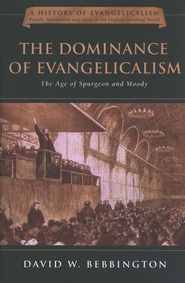David Bebbington: The Dominance of Evangelicalism
 David Bebbington, The Dominance of Evangelicalism: The Age of Spurgeon and Moody (Downers Grove: InterVarsity Press, 2005), 288 pages, ISBN 9780830825837.
David Bebbington, The Dominance of Evangelicalism: The Age of Spurgeon and Moody (Downers Grove: InterVarsity Press, 2005), 288 pages, ISBN 9780830825837.
In The Dominance of Evangelicalism: The Age of Spurgeon and Moody, David Bebbington provides an outstanding introduction to modern evangelicalism by tracing its origins. In most treatments of the subject the distinguishing characteristic is usually along theological lines. That is, evangelicals are normally (at least until recently) defined in terms of what they believe. For example Alister McGrath in his Evangelicalism and the Future of Christianity gives a list of “six fundamental convictions”1 that define evangelicalism, and Stan Grenz gives a similar list in his Revisioning Evangelical Theology.2 This kind definition-by-list could be cited over and over;3 the lists may vary, but it is almost always the discipline of theology that brings the planets of evangelicalism into their proper orbit. Bebbington, however, approaches the subject with a slight variation. He contends that evangelicals are first and foremost a people of the book—a Bible people (pages 23-26). Secondarily, they are a people with a message—the message of the cross (26-31). A third element in Bebbington’s explanation is the utter need and centrality of conversion—men and women must be “born again” (31-36). The final component which constitutes evangelicalism, is what Bebbington calls “activism” (36-40). Here he has in mind nothing more than the idea that someone who is truly born-again will live differently. What Wesley and other eighteenth century theologians called experimental religion—the actual lived-out experience of knowing God in everyday living.4
The author begins his examination of evangelicalism’s impact by focusing on two particularly influential representatives: Charles H. Spurgeon and Dwight L. Moody. It should be understood, however, that this volume is not a biography on Spurgeon or Moody. In total, only eleven pages are devoted to biographical elements, as such. Rather, the focus of the work is directed to examining the ways in which evangelicalism has influenced the world over the past century and a half. There are questions that Bebbington raises that challenge the way in which denominational lines are currently drawn. For example, within the evangelical world today, we usually make dividing lines along national boarders. However, the historical reasons behind this are remarkably complex. “Normally…the church history of Scottish Presbyterians has been written as though Scotland were the only natural unit for study. Equally, however, the Reformed tradition in different lands during the Victorian era, as a recent volume has shown, forms a suitable topic for investigation. The book includes Scottish congregations but highlights their similarities to Presbyterians in American and Congregationalists in England.”5
One of the most significant historical changes Bebbington tracks was the transition from enlightenment thinking to what became known as Romanticism. “[Romanticism] was a diverse and evolving phenomenon, but its essential temper can be identified by contrast with the Enlightenment. Instead of exalting reason, those touched by the new spirit of the times placed their emphasis on will, spirit and emotion” (148). This “Romantic spirit” (149) affected Christianity as well, and Bebbington demonstrates this throughout the second half of the volume. Evangelicalism responded to the challenges of Romanticism in at least three ways. The first way evangelicals responded was associated with the faith principle embodied in the practice of George Müller (259). “The idea of undertaking some venture in entire dependence on divine provision gathered support as the century wore on. It was applied to finance, to healing and above all to missions” (259). A second way in which evangelicalism responded to the threat of Romanticism was through the rapid growth of premillennial teaching. Premillennialism had not always been at the core of evangelicalism (137-141), but with the new challenges that were raised through the advent of Romanticism, Premillennialism became a central feature (259). The third and final way in which evangelicalism answered the challenge of Romanticism came in the various forms of the holiness teachings. Within the reformed churches it usually came in the form of the Keswick movement. Within the Wesleyan or Methodist traditions it came out in what became known as “entire sanctification.”6 Additionally, Bebbington argues that this third response of evangelicalism also was the impetus behind Spurgeon’s strident resistance in what became known as the “Downgrade Controversy” (260). Simply put, advancements in the natural sciences in the late nineteenth century called into question many long-held assumptions about virtually every aspect of life. Eventually this led many within Spurgeon’s own denomination (he was a Baptist) to also call into question the truthfulness and accuracy of Scripture. Spurgeon simply would not sit idly by and say nothing. “From our inmost souls, we loathe all mystic and rationalistic obscurations of the plain and full-orbed doctrines of grace” (260).7 Although the pressure of the conflict nearly ended his life, Spurgeon ultimately emerged victoriously from this conflict.
Category: Church History, Summer 2007


